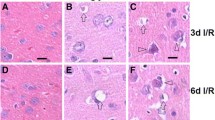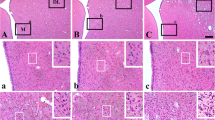Abstract
We undertook a detailed characterization of the cellular responses to acute global cerebral ischemia complicated by hyperglycemia. Anesthetized, physiologically monitored male Wistar rats received 12.5 min of global forebrain ischemia by bilateral common carotid artery occlusions plus hemorrhagic hypotension to 45 mm Hg. Cranial temperature was maintained at normothermic levels. Hyperglycemic animals received dextrose (2.5 ml of a 25% solution, intraperitoneally) prior to ischemia; this doubled the mean plasma glucose concentration to 296 mg/100 ml. At 3 days (n = 10) or 24 h (n = 4) after ischemia, brains were perfusion-fixed and paraffin-embedded for light microscopic histopathology and for the histochemical visualization of activated microglia and the immunocytochemical visualization of glial fibrillary acid protein. Normal-neuron counts in the vulnerable hippocampal CA1 sector of hyperglycemic-ischemic (HI) rats were reduced to one-third the number observed in normoglycemic-ischemic (NI) animals. Ischemic cell counts in the striatum were increased fivefold or more in HI compared to NI rats, and normal small-neuron counts were reduced by two-thirds. The neocortex and striatum of NI rats showed only mild damage, while the majority of HI rats had extensive lesions, and several showed large cortical, striatal or thalamic infarcts. In addition, widespread cortical ischemic neuronal changes were evident in HI animals. No endothelial alterations were present in NI rats. By contrast, HI rats showed prominent peri- and intravascular polymorphonuclear and monocytic accumulation evident at 24 h; frequent white cell thrombi in pial arterioles on day 3; and thickening of vascular endothelium, with foci of parenchymal rarefaction or microinfarction adjacent to occluded vessels. Prominent microglial activation, often along the course of penetrating blood vessels, was common in the striatum and neocortex of HI animals but was much less extensive in the NI group. Activated microglia in HI rats were typically hypertrophic and amoeboid. These results suggest that the detrimental influence of hyperglycemia in ischemia is initially mediated by an action on vascular endothelium, which in turn leads to widespread foci of infarction and neuronal loss.
Similar content being viewed by others
Author information
Authors and Affiliations
Additional information
Received: 18 March 1998 / Revised, accepted: 2 June 1998
Rights and permissions
About this article
Cite this article
Lin, B., Ginsberg, M. & Busto, R. Hyperglycemic exacerbation of neuronal damage following forebrain ischemia: microglial, astrocytic and endothelial alterations. Acta Neuropathol 96, 610–620 (1998). https://doi.org/10.1007/s004010050942
Issue Date:
DOI: https://doi.org/10.1007/s004010050942




